Hungerford T.W., Shaw D.J. Contemporary Precalculus: A Graphing Approach
Подождите немного. Документ загружается.

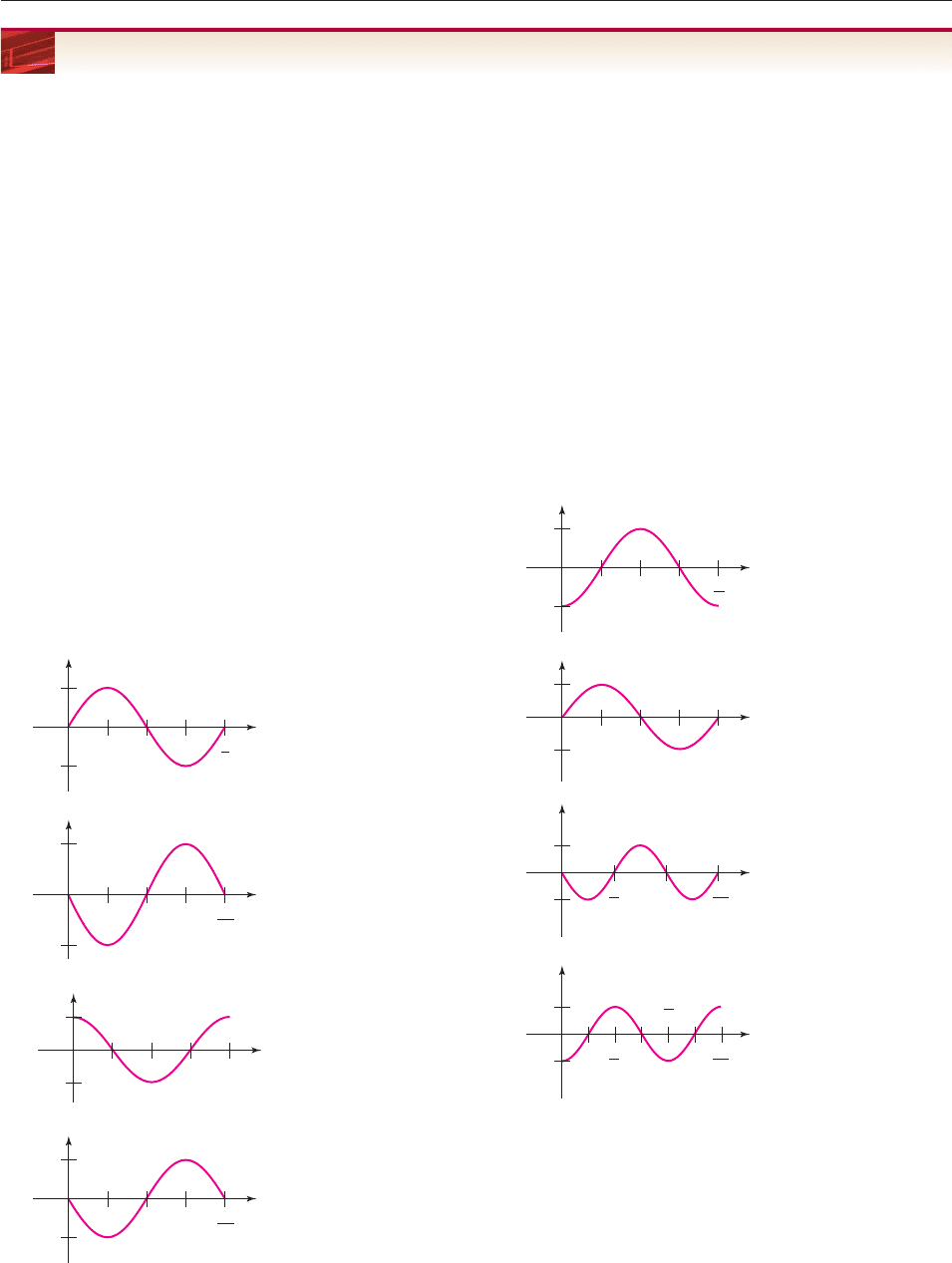
486 CHAPTER 6 Trigonometric Functions
EXERCISES 6.5
In Exercises 1–7, state the amplitude, period, and phase shift of
the function.
1. g(t) 3 sin(2t p) 2. h(t) 6 cos(4t p/4)
3. q(t) 5 sin(5t 1/5)
4. g(t) 97 cos(14t 5)
5. f(t) cos 2pt 6. k(t) cos(2p t/3)
7. p(t) 6 cos(3pt 1)
8. (a) What is the period of f (t) sin 2pt?
(b) For what values of t (with 0 t 2p) is f (t) 0?
(c) For what values of t (with 0 t 2p) is f (t) 1? or
f (t) 1?
In Exercises 9–14, give the rule of a periodic function with
the given numbers as amplitude, period, and phase shift (in
this order).
9. 3, p/4, p/5 10. 4, 5, 0 11. 3/4, 2, 0
12. 4/5, 3, 1 13. 7, 5/3, p/2 14. 18, 3, 6
In Exercises 15–18, state the rule of a function of the form
f (t) A sin bt or g(t) A cos bt whose graph appears to be
identical to the given graph.
15.
16.
17.
18.
2π
5
5
−5
0
t
y
4π
1.5
−1.5
0
t
y
2π
3
3
−3
0
t
y
π
2
2
−2
0
t
y
In Exercises 19–22,
(a) State the period of the function.
(b) Describe the graph of the function between 0 and 2p.
(c) Find a viewing window that accurately shows exactly four
complete waves of the graph.
19. f (t) sin 200t 20. f (t) sin 600t
21. g(t) cos 900t 22. g(t) cos 575t
In Exercises 23–26,
(a) State the rule of a function of the form
f(t) A sin(bt c)
whose graph appears to be identical with the given graph.
(b) State the rule of a function of the form
g(t) A cos(bt c)
whose graph appears to be identical with the given graph.
23.
24.
25.
26.
In Exercises 27–32, sketch a complete graph of the function.
27. k(t) 3 sin t 28. y(t) 2 cos 3t
29. p(t)
1
2
sin 2t 30. q(t)
2
3
cos
3
2
t
31. h(t) 3 sin(2t p/2) 32. p(t) 3 cos(3t p)
3π
4
1
−1
π
4
π
2
3π
2
1
−1
ππ
2
2
18
−18
0
t
y
π
5
12
−12
0
t
y

In Exercises 33–36, graph the function over the interval
[0, 2p) and determine the location of all local maxima and
minima. [This can be done either graphically or algebraically.]
33. f (t)
1
2
sin
t
p
3
34. g(t) 2 sin(2t/3 p/9)
35. f (t) 2 sin(3t p)
36. h(t)
1
2
cos
p
2
t
p
8
1
In Exercises 37–40, graph f (t) in a viewing window with
2p t 2p. Use a maximum finder and a root finder to
determine constants A, b, c such that the graph of f (t) appears
to coincide with the graph of g(t) A sin(bt c).
37. f (t) 3 sin t 2 cos t
38. f(t) 5 sin t 3 cos t
39. f (t) 3 sin(4t 2) 2 cos(4t 1)
40. f (t) 2 sin(3t 5) 3 cos(3t 2)
In Exercises 41 and 42, explain why there could not
possibly be constants A, b, and c such that the graph of
g(t) A sin(bt c) coincides with the graph of f (t).
41. f (t) sin 2t cos 3t
42. f (t) 2 sin(3t 1) 3 cos(4t 1)
43. Do parts (a) and (b) of Example 9 for a person whose blood
pressure is given by
g(t) 21 cos(2.5pt) 113.
According to current guidelines, someone with systolic
pressure above 140 or diastolic pressure above 90 has high
blood pressure and should see a doctor about it. What would
you advise the person in this case?
44. Find the function in Example 10 if the wheel has a radius of
13 centimeters and the rod is 18 centimeters long.
45. The volume V(t) of air (in cubic inches) in an adult’s lungs
t seconds after exhaling is approximately
V(t) 55 24.5 sin
p
2
x
p
2
.
(a) Find the maximum and minimum amount of air in the
lungs.
(b) How often does the person exhale?
(c) How many breaths per minute does the person take?
46. The brightness of the binary star Beta Lyrae (as seen from
the earth) varies. Its visual magnitude M(t) after t days is
approximately
M(t) .55 cos(.97t) 3.85.
The visual magnitude scale is reversed from what you
would expect: The lower the number, the brighter the star.
With this in mind, answer the following questions.
SECTION 6.5 Periodic Graphs and Simple Harmonic Motion 487
(a) Graph the function M when 0 t 21.
(b) What is the visual magnitude when the star is brightest?
When it is dimmest?
(c) What is the period of the magnitude (the interval
between its brightest times)?
47. The current generated by an AM radio transmitter is given
by a function of the form f (t) A sin 2000pmt, where
550 m 1600 is the location on the broadcast dial and
t is measured in seconds. For example, a station at 980 on
the AM dial has a function of the form
f (t) A sin 2000p(980)t A sin 1,960,000pt.
Sound information is added to this signal by varying (mod-
ulating) A, that is, by changing the amplitude of the waves
being transmitted. (AM means “amplitude modulation.”)
For a station at 980 on the dial, what is the period of func-
tion f ? What is the frequency (number of complete waves
per second)?
48. The number of hours of daylight in Winnipeg, Manitoba,
can be approximated by
d(t) 4.15 sin(.0172t 1.377) 12,
where t is measured in days, with t 1 being January 1.
(a) On what day is there the most daylight? The least? How
much daylight is there on these days?
(b) On which days are there 11 hours or more of daylight?
(c) What do you think the period of this function is? Why?
49. The original Ferris wheel, built by George Ferris for the
Columbian Exposition of 1893, was much larger and slower
than its modern counterparts: It had a diameter of 250 feet
and contained 36 cars, each of which held 60 people; it
made one revolution every 10 minutes. Imagine that the
Ferris wheel revolves counterclockwise in the x-y plane
with its center at the origin. A car had coordinates (125, 0)
at time t 0. Find the rule of a function that gives the
y-coordinate of the car at time t.
125
125
−125
x
y
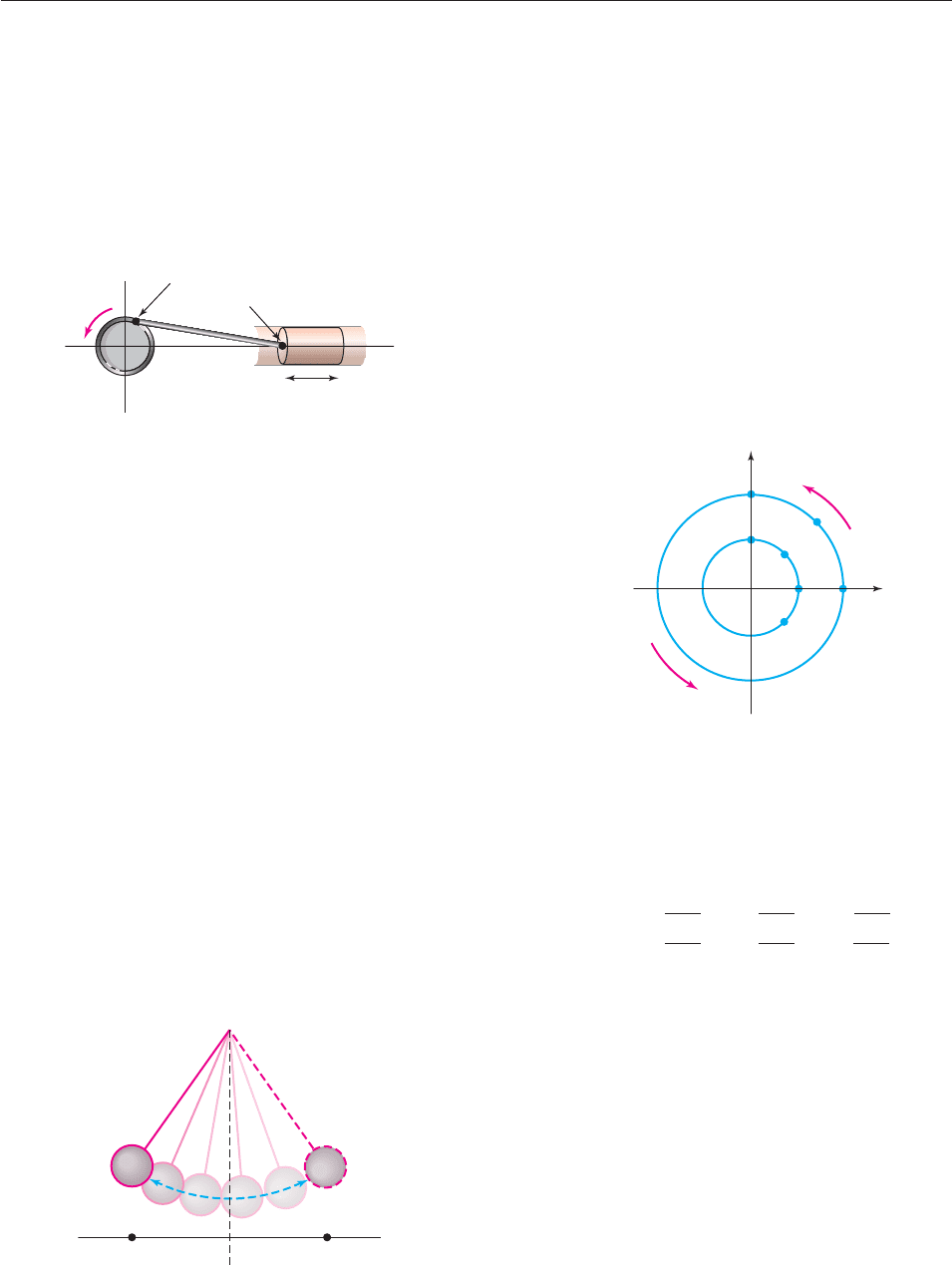
50. Do Exercise 49 if the wheel turns at 2 radians per minute
and the car is at (0, 125) at time t 0.
51. A circular wheel of radius 1 foot rotates counterclockwise.
A 4-foot-long rod has one end attached to the edge of this
wheel and the other end to the base of a piston (see the fig-
ure). It transfers the rotary motion of the wheel into a back-
and-forth linear motion of the piston. If the wheel is rotating
at 10 revolutions per second, point W is at (1, 0) at time
t 0, and point P is always on the x-axis, find the rule of a
function that gives the x-coordinate of P at time t.
52. Do Exercise 51 if the wheel has a radius of 2 feet, rotates at
50 revolutions per second, and is at (2, 0) when t 0.
In Exercises 53–56, suppose there is a weight hanging from a
spring (under the same idealized conditions as described in
Example 11). The weight is given a push to start it moving. At
any time t, let h(t) be the height (or depth) of the weight above
(or below) its equilibrium point. Assume that the maximum dis-
tance the weight moves in either direction from the equilibrium
point is 6 centimeters and that it moves through a complete
cycle every 4 seconds. Express h(t) in terms of the sine or
cosine function under the stated conditions.
53. Initial push is upward from the equilibrium point.
54. Initial push is downward from the equilibrium point.
[Hint: What does the graph of A sin bt look like when
A 0?]
55. Weight is pulled 6 centimeters above equilibrium, and the
initial movement (at t 0) is downward. [Hint: Think
cosine.]
56. Weight is pulled 6 centimeters below equilibrium, and the
initial movement is upward.
57. A pendulum swings uniformly back and forth, taking
2 seconds to move from the position directly above point A
to the position directly above point B.
BA
−11
W
P
−1
1
488 CHAPTER 6 Trigonometric Functions
The distance from A to B is 20 centimeters. Let d(t) be the
horizontal distance from the pendulum to the (dashed) cen-
ter line at time t seconds (with distances to the right of the
line measured by positive numbers and distances to the left
by negative ones). Assume that the pendulum is on the cen-
ter line at time t 0 and moving to the right. Assume that
the motion of the pendulum is simple harmonic motion.
Find the rule of the function d(t).
58. The diagram shows a merry-go-round that is turning coun-
terclockwise at a constant rate, making 2 revolutions in
1 minute. On the merry-go-round are horses A, B, C, and D
at 4 meters from the center and horses E, F, and G at
8 meters from the center. There is a function a(t) that gives
the distance the horse A is from the y-axis (this is the
x-coordinate of the position A is in) as a function of time t
(measured in minutes). Similarly, b(t) gives the x-coordinate
for B as a function of time, and so on. Assume that the dia-
gram shows the situation at time t 0.
(a) Which of the following functions does a(t) equal?
4 cos t, 4 cos pt, 4 cos 2t, 4 cos 2pt,
4 cos
1
2
t, 4 cos ((p/2)t), 4 cos 4pt
Explain.
(b) Describe the functions b(t), c(t), d(t), and so on using
the cosine function:
b(t) , c(t) , d(t) .
e(t) , f (t) , g(t) .
(c) Suppose the x-coordinate of a horse S is given by the
function 4 cos(4pt (5p/6)) and the x-coordinate
of another horse T is given by 8 cos(4pt (p/3)).
Where are these horses located in relation to the rest of
the horses? Mark the positions of T and S at t 0 into
the figure.
Exercises 59–60 explore various ways in which a calculator
can produce inaccurate or misleading graphs of trigonometric
functions.
59. (a) If you were going to draw a rough picture of a full wave
of the sine function by plotting some points and con-
necting them with straight-line segments, approxi-
mately how many points would you have to plot?
x
y
G
F
E
A
D
C
B
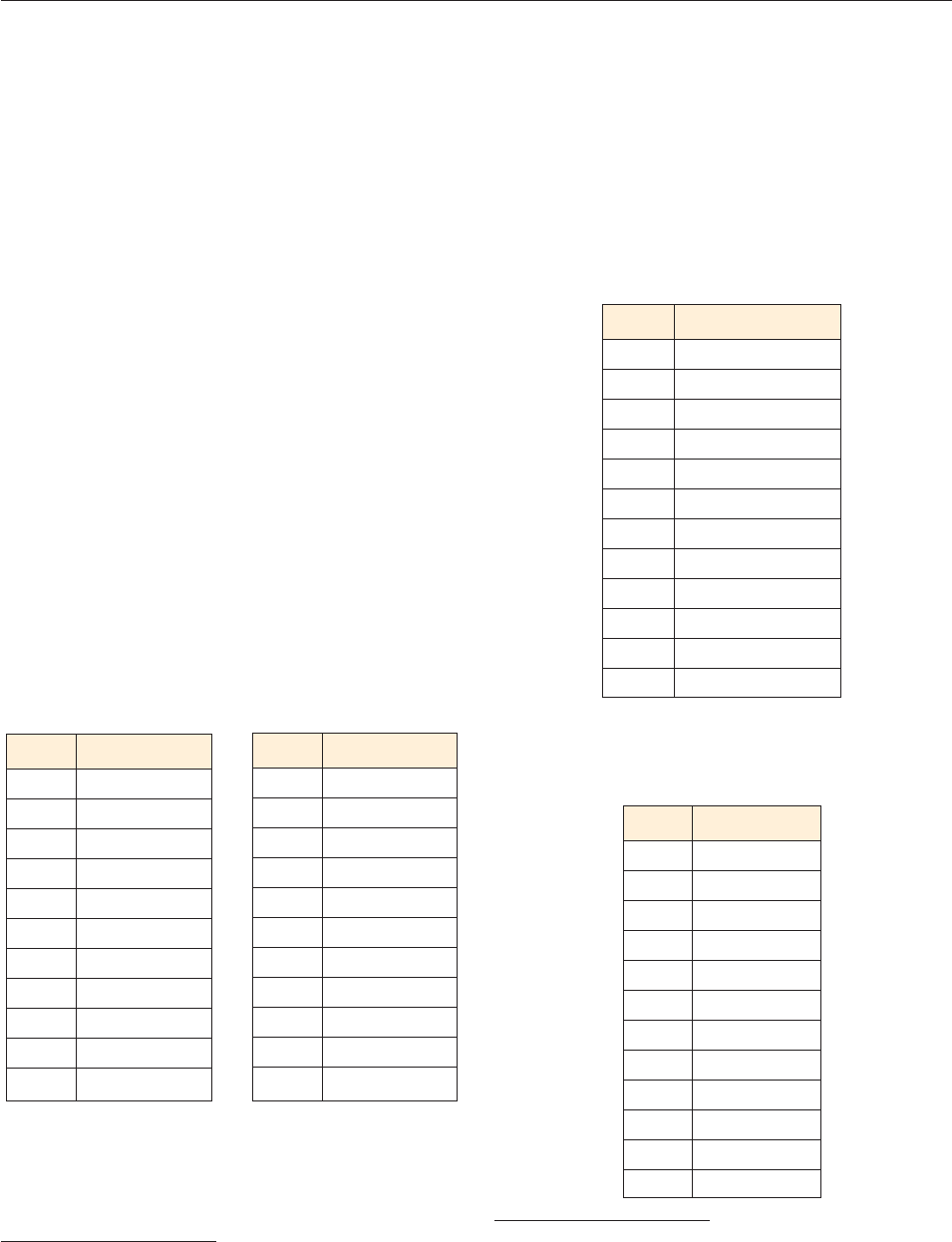
(b) If you were drawing a rough sketch of the graph of
f (t) sin 100t when 0 t 2p, according to the
method in part (a), approximately how many points
would have to be plotted?
(c) How wide (in pixels) is your calculator screen? Your
answer to this question is the maximum number of
points that your calculator plots when graphing any
function.
(d) Use parts (a)–(c) to explain why your calculator cannot
possibly produce an accurate graph of f (t) sin 100t in
any viewing window with 0 t 2p.
60. (a) Using a viewing window with 0 t 2p, use the trace
feature to move the cursor along the horizontal axis.
[On some calculators, it may be necessary to graph
y 0 to do this.] What is the distance between one pixel
and the next (to the nearest hundredth)?
(b) What is the period of f (t) sin 300t? Since the period
is the length of one full wave of the graph, approxi-
mately how many waves should there be between two
adjacent pixels? What does this say about the possibil-
ity of your calculator’s producing an accurate graph of
this function between 0 and 2p?
61. The table below shows the number of unemployed people in
the labor force (in millions) for 1984–2005.*
(a) Sketch a scatter plot of the data, with x 0 correspon-
ding to 1980.
(b) Does the data appear to be periodic? If so, find an
appropriate model.
(c) Do you think this model is likely to be accurate much
beyond 2005? Why?
In Exercises 62 and 63, do the following.
(a) Use 12 data points (with x 1 corresponding to January)
to find a periodic model of the data.
SECTION 6.5 Periodic Graphs and Simple Harmonic Motion 489
(b) What is the period of the function found in part (a)? Is this
reasonable?
(c) Plot 24 data points (two years) and graph the function
from part (a) on the same screen. Is the function a good
model in the second year?
(d) Use the 24 data points in part (c) to find another periodic
model for the data.
(e) What is the period of the function in part (d)? Does its
graph fit the data well?
62. The table shows the average monthly temperature in
Chicago, IL, based on data from 1971 to 2000.*
63. The table shows the average monthly precipitation (in
inches) in San Francisco, CA, based on data from 1971 to
2000.
†
Month Temperature (°F)
Jan 22.0
Feb 27.0
Mar 37.3
Apr 47.8
May 58.7
Jun 68.2
Jul 73.3
Aug 71.7
Sep 63.8
Oct 52.1
Nov 39.3
Dec 27.4
Month Precipitation
Jan 4.45
Feb 4.01
Mar 3.26
Apr 1.17
May .38
Jun .11
Jul .03
Aug .07
Sep .2
Oct 1.04
Nov 2.49
Dec 2.89
Year Unemployed
1984 8.539
1985 8.312
1986 8.237
1987 7.425
1988 6.701
1989 6.528
1990 7.047
1991 8.628
1992 9.613
1993 8.940
1994 7.996
Year Unemployed
1995 7.404
1996 7.236
1997 6.739
1998 6.210
1999 5.880
2000 5.692
2001 6.801
2002 8.378
2003 8.774
2004 8.149
2005 7.591
*National Climatic Data Center.
†
National Climatic Data Center.
*U.S. Bureau of Labor Statistics.
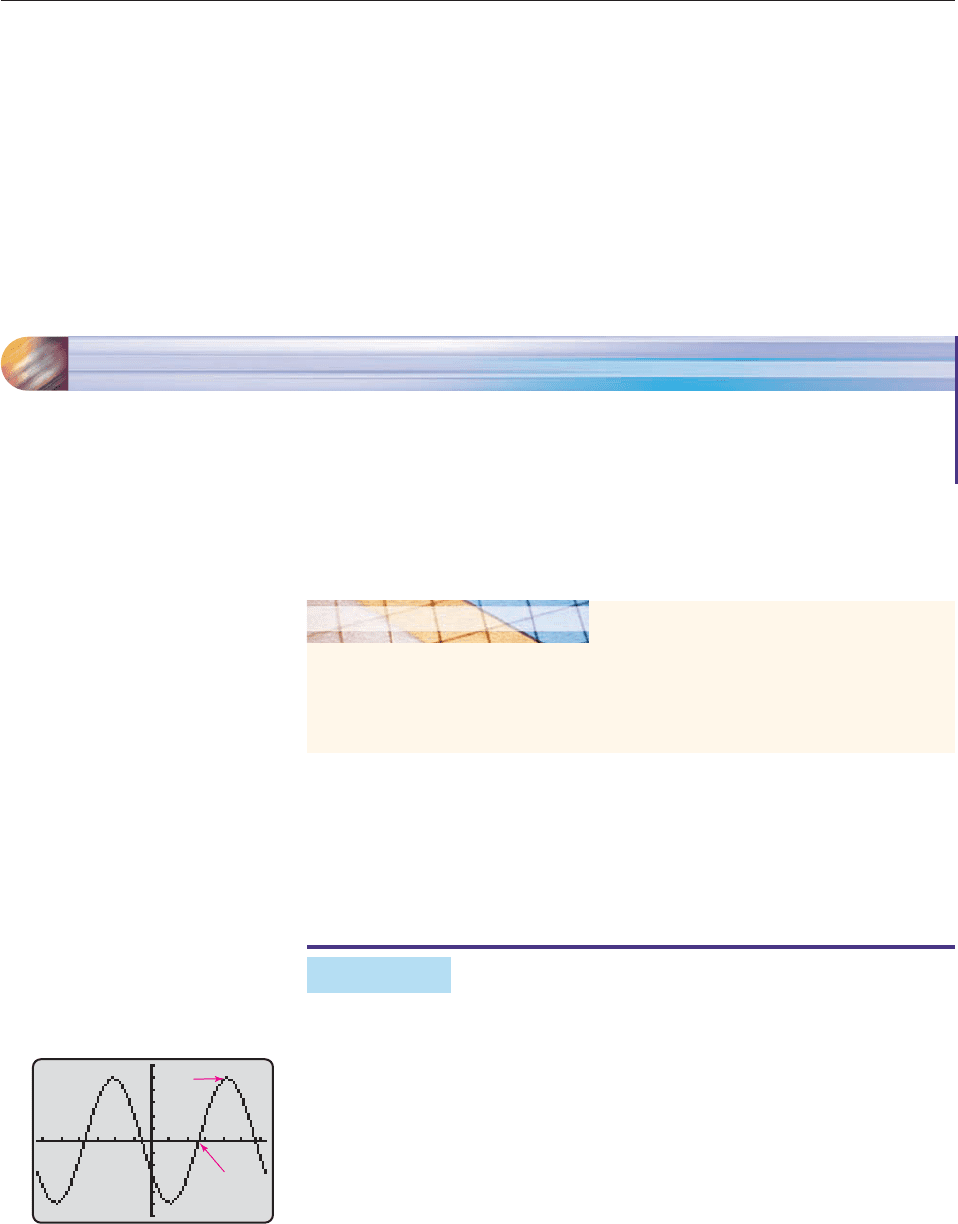
THINKERS
64. On the basis of the results of Exercises 37–42, under what
conditions on the constants a, k, h, d, r, s does it appear that
the graph of
f (t) a sin(kt h) d cos(rt s)
coincides with the graph of the function
g(t) A sin(bt c)?
65. A grandfather clock has a pendulum length of k meters
and its swing is given (as in Exercise 57) by the function
490 CHAPTER 6 Trigonometric Functions
f (t) .25 sin(vt), where
v
9
k
.8
.
(a) Find k such that the period of the pendulum is 2 sec-
onds.
(b) The temperature in the summer months causes the pen-
dulum to increase its length by .01%. How much time
will the clock lose in June, July, and August? [Hint:
These three months have a total of 92 days (7,948,800
seconds). If k is increased by .01%, what is f (2)?]
6.5.A SPECIAL TOPICS Other Trigonometric Graphs
■ Explore the behavior of sinusoidal functions and their graphs.
■ Explore the graphs of damped and compressed trigonometric
functions.
A graphing calculator or computer enables you to explore with ease a wide vari-
ety of trigonometric functions.
Graph
g(t) cos t and f (t) sin(t p/2)
on the same screen. Is there any apparent difference between the two graphs?
GRAPHING EXPLORATION
This exploration suggests that the equation cos t sin(t p/2) is an identity
and hence that the graph of the cosine function can be obtained by horizontally
shifting the graph of the sine function. This is indeed the case, as will be proved in
Section 7.2. Consequently, every graph in Section 6.5 is actually the graph of a
function of the form f (t) A sin(bt c). In fact, considerably more is true.
EXAMPLE 1
Show that the graph of
g(t) 2 sin(t 7) 3 cos(t 2)
appears identical to the graph of a function of the form f (t) A sin(bt c) for
suitable constants A, b, and c.
SOLUTION The function g(t) has period 2p because this is the period of both
sin(t 7) and cos(t 2). Its graph in Figure 6–73 consists of repeating waves of
uniform height. By using a maximum finder and a root finder, we see that the
maximum height of a wave is approximately 4.95 and that a wave similar to a
sine wave begins at approximately t 2.60, as indicated in Figure 6–73. Thus, the
Section Objectives
−
6
−2π 2π
6
4.95
2.60
Figure 6–73

graph looks very much like a sine wave with amplitude 4.95 and phase shift 2.60.
As we saw in Section 6.5, the function
f (t) 4.95 sin(t 2.60)
has amplitude of 4.95, period 2p/1 2p, and phase shift (2.60)/1 2.60.
SPECIAL TOPICS 6.5.A Other Trigonometric Graphs 491
Graph
g(t) 2 sin(t 7) 3 cos(t 2)
and
f(t) 4.95 sin(t 2.60)
on the same screen. Do the graphs look identical?
GRAPHING EXPLORATION
Example 1 is an illustration (but not a proof ) of the following fact.
Sinusoidal
Graphs
If b, D, E, r, s are constants, then the graph of the function
g(t) D sin(bt r) E cos(bt s)
is a sine curve: There exist constants A and c such that
D sin(bt r) E cos(bt s) A sin(bt c).
EXAMPLE 2
Estimate the constants A, b, c such that
A sin(bt c) 4 sin(3t 2) 2 cos(3t 4).
SOLUTION The function g(t) 4 sin(3t 2) 2 cos(3t 4) has period
2p/3 because this is the period of both sin(3t 2) and cos(3t 4). The function
f (t) A sin(bt c) has period 2p/b. So we must have
2
b
p
2
3
p
, or equivalently, b 3.
Using a maximum finder and a root finder on the graph of
g(t) 4 sin(3t 2) 2 cos(3t 4)
in Figure 6–74, we see that the maximum height (amplitude) of a wave is approx-
imately 3.94 and that a sine wave begins at approximately t .84. Therefore,
the graph has (approximate) amplitude 3.94 and phase shift .84. Since b 3 and
f (t) A sin(bt c) has amplitude A and phase shift c/b c/3, we have
A 3.94 and
3
c
.84 or, equivalently, c 3(.84) 2.52.
−5
−2π 2π
5
−.84
3.94
Figure 6–74
■

Therefore,
3.94 sin(3t 2.52) 4 sin(3t 2) 2 cos(3t 4).
492 CHAPTER 6 Trigonometric Functions
Graphically confirm this fact by graphing
f (t) 3.94 sin(3t 2.52)
and
g(t) 4 sin(3t 2) 2 cos(3t 4)
on the same screen. Do the graphs appear identical?
GRAPHING EXPLORATION
Graph each of the following functions separately in the viewing window with
2p t 2p and 6 y 6.
f (t) sin 3t cos 2t, g(t) 2 sin(3t 5) 4 cos(t 2),
h(t) 2 sin 2t 3 cos 3t.
GRAPHING EXPLORATION
In the preceding examples, the variable t had the same coefficient in both the
sine and cosine term of the function’s rule. When this is not the case, the graph
will consist of waves of varying size and shape, as you can readily illustrate.
EXAMPLE 3
Find a complete graph of
f (t) 4 sin 100pt 2 cos 40pt.
SOLUTION If you graph f in a window with 2p t 2p, you will get
garbage on the screen (try it!). Trial and error might lead to a viewing window that
shows a readable graph, but the graph might not be accurate. A better procedure
is to note that this is a periodic function. Hence, we need only graph it over one
period to have a complete graph.
To find the period of f(t), we must first find the periods of its components,
sin 100pt and of cos 40 pt.
Period of sin 100 pt
1
2
0
p
0p
5
1
0
.02
Period of cos 40 pt
4
2
0
p
p
2
1
0
.05
The period of f(t) 4 sin 100 pt 2 cos 40 pt is the least common integer mul-
tiple of .02 and .05. The integer multiples of .02 are:
.02, 2(.02), 3(.02), 4(.02), 5(.02), 6(.02), . . .
that is,
.02, .04, .06, .08, .10, .12, . . .
■

Similarly, the integer multiples of .05 are
.05, 2(.05) .10, . . .
We need go no further, since we now see that .1 is the smallest number that is on
both lists. Hence, the period of f(t) is .1. By graphing f in the viewing window with
0 t .1 and 6 y 6, we obtain the complete graph in Figure 6–75. ■
DAMPED AND COMPRESSED TRIGONOMETRIC GRAPHS
Many physical situations can be described by functions whose graphs consist of
waves of different heights. Other situations (for instance, sound waves in FM radio
transmission) are modeled by functions whose graphs consist of waves of uniform
height and varying frequency. Here are some examples of such functions.
EXAMPLE 4
Explain why the graph of f (t) t cos t in Figure 6–76 has the shape it does.
SOLUTION The graph appears to consist of waves that get larger and larger as
you move away from the origin. To explain this situation, we analyze the situation
algebraically. We know that
1 cos t 1 for every t.
If we multiply each term of this inequality by t and remember the rules for chang-
ing the direction of inequalities when multiplying by negatives, we see that
t t cos t t when t 0
and
t t cos t t when t 0.
In graphical terms, this means that the graph of f (x) t cos t lies between the
straight lines y t and y t, with the waves growing larger or smaller to fill
this space. The graph touches the lines y t exactly when t cos t t, that is,
when cos t 1. This occurs when t 0, p, 2p, 3p,
SPECIAL TOPICS 6.5.A Other Trigonometric Graphs 493
−6
0.1
6
Figure 6–75
−35
35
−35 35
Figure 6–76
Illustrate this analysis by graphing f (t) t cos t, y t, and y t on the same screen.
GRAPHING EXPLORATION
EXAMPLE 5
No single viewing window gives a completely readable graph of g(t) .5
t
sin t
(try some). To the left of the y-axis, the graph gets quite large, but to the right,
it almost coincides with the horizontal axis. To get a better mental picture,
note that .5
t
0 for every t. Multiplying each term of the known inequality
1 sin t 1 by .5
t
, we see that
.5
t
.5
t
sin t .5
t
for every t.
Hence, the graph of g lies between the graphs of the exponential functions
y .5
t
and y .5
t
, which are shown in Figure 6–77 on the next page. The graph
■
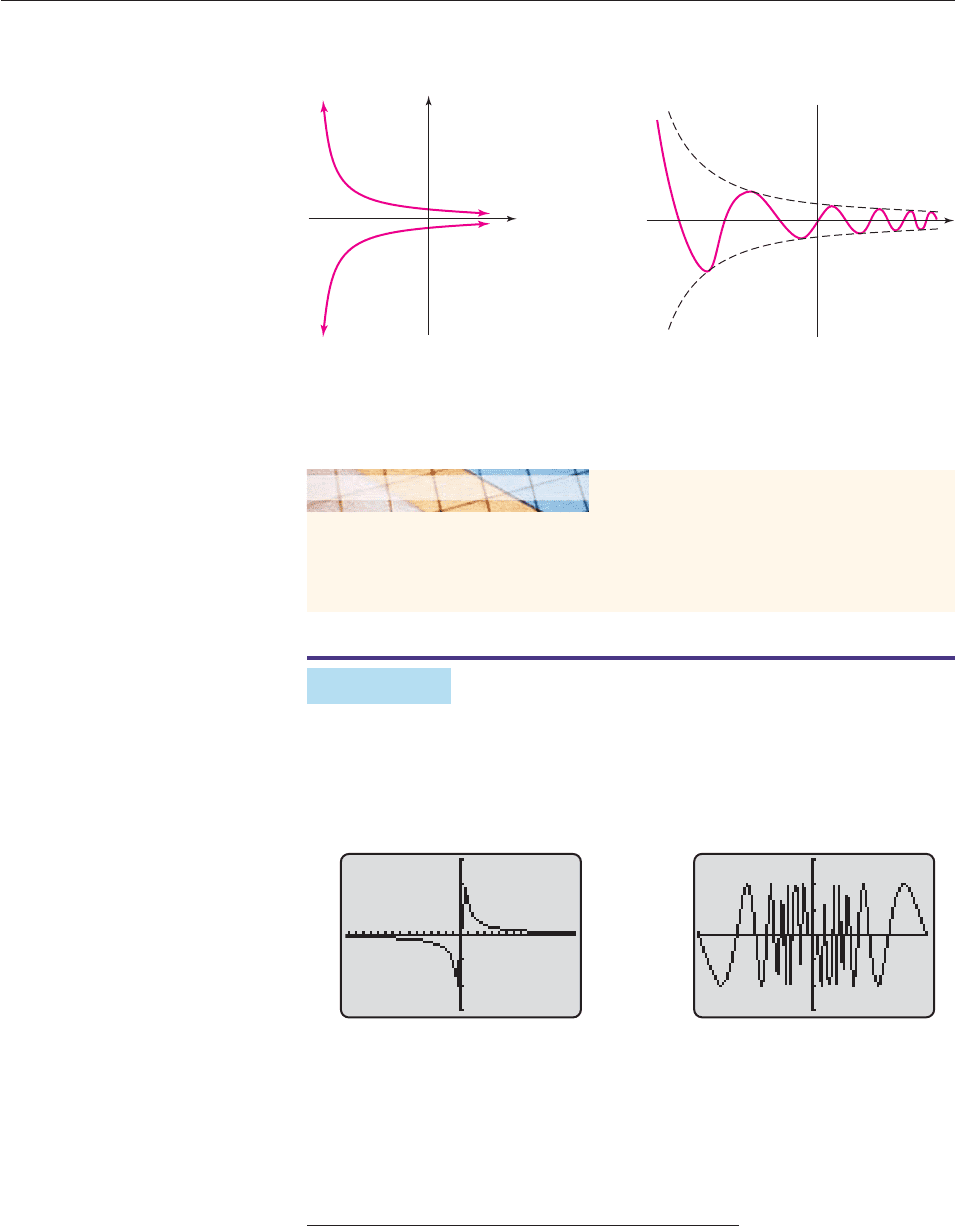
of g will consist of sine waves rising and falling between those exponential
graphs, as indicated in the sketch in Figure 6–78 (which is not to scale).
494 CHAPTER 6 Trigonometric Functions
y = .5
t
y =−.5
t
t
y
t
Figure 6–77
Figure 6–78
The best you can do with a calculator is to look at various viewing windows in
which a portion of the graph is readable.
Find viewing windows that clearly show the graph of g(t) .5
t
sin t in each of these
ranges.
2p t 0, 0 t 2p,2p t 4p.
GRAPHING EXPLORATION
EXAMPLE 6
If you graph f (t) sin(p/t) in a wide viewing window such as Figure 6–79, it is
clear that the horizontal axis is an asymptote of the graph.* Near the origin, how-
ever, the graph is not very readable, even in a very narrow viewing window like
Figure 6–80.
−1.5
−76 76
1.5
−1.5
−.5 .5
1.5
Figure 6–79
Figure 6–80
*This can also be demonstrated algebraically: When t is very large in absolute value, then p/t is very
close to 0 by the Big-Little Principle, and hence, sin(p/t) is very close to 0 as well.
To understand the behavior of f near the origin, consider what happens as you
move left from t 1/2 to t 0:
As t goes from
1
2
to
1
4
, then
p
t
goes from
1
p
/2
2p to
1
p
/4
4p.
■
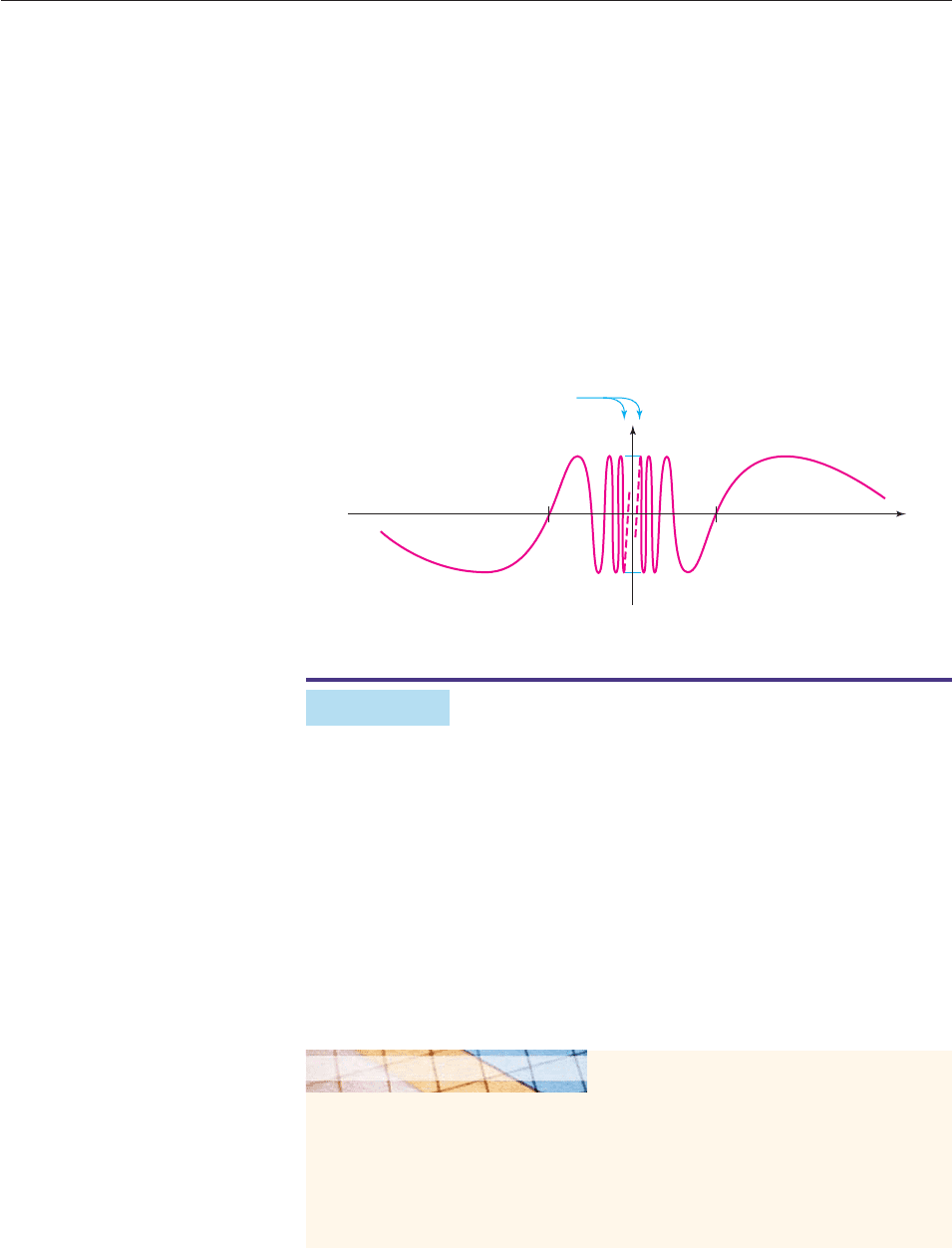
As p/t takes all values from 2p to 4p, the graph of f (t) sin(p/t) makes one
complete sine wave. Similarly,
As t goes from
1
4
to
1
6
, then
p
t
goes from
1
p
/4
4p to
1
p
/6
6p.
As p/t takes all values from 4p to 6p, the graph of f (t) sin(p/t) makes another
complete sine wave. The same pattern continues, so the graph of f makes a com-
plete wave from t 1/2 to t 1/4, another from t 1/4 to t 1/6, another
from t 1/6 to t 1/8, and so on. A similar phenomenon occurs as t takes val-
ues between 1/2 and 0. Consequently, the graph of f near 0 oscillates infinitely
often between 1 and 1, with the waves becoming more and more compressed as
t gets closer to 0, as indicated in Figure 6–81. Since the function is not defined at
t 0, the left and right halves of the graph are not connected. ■
SPECIAL TOPICS 6.5.A Other Trigonometric Graphs 495
Graph oscillates
infinitely often here
f(t) = sin (π/t)
1
−1
−11
t
y
Figure 6–81
EXAMPLE 7
Describe the graph of g(t) cos e
t
.
SOLUTION When t is negative, then e
t
is very close to 0 (why?), and hence,
cos e
t
is very close to 1. Therefore, the horizontal line y 1 is an asymptote of the
half of the graph to the left of the origin. As t takes increasing positive values, the
corresponding values of e
t
increase at a much faster rate (remember exponential
growth). For instance, as t goes from 0 to 2p,
e
t
goes from e
0
1 to e
2p
535.5 170p 85(2p).
Consequently, cos e
t
runs through 85 periods, that is, the graph of g makes 85 full
waves between 0 and 2p. As t gets larger, the graph of g makes waves at a faster
and faster rate.
To see how compressed the waves become, graph g(t) in three viewing windows,
with
0 t 3.5, 4.5 t 5, 6 t 6.2,
and note how the number of waves increases in each succeeding window, even
though the widths of the windows are getting smaller.
GRAPHING EXPLORATION
■
